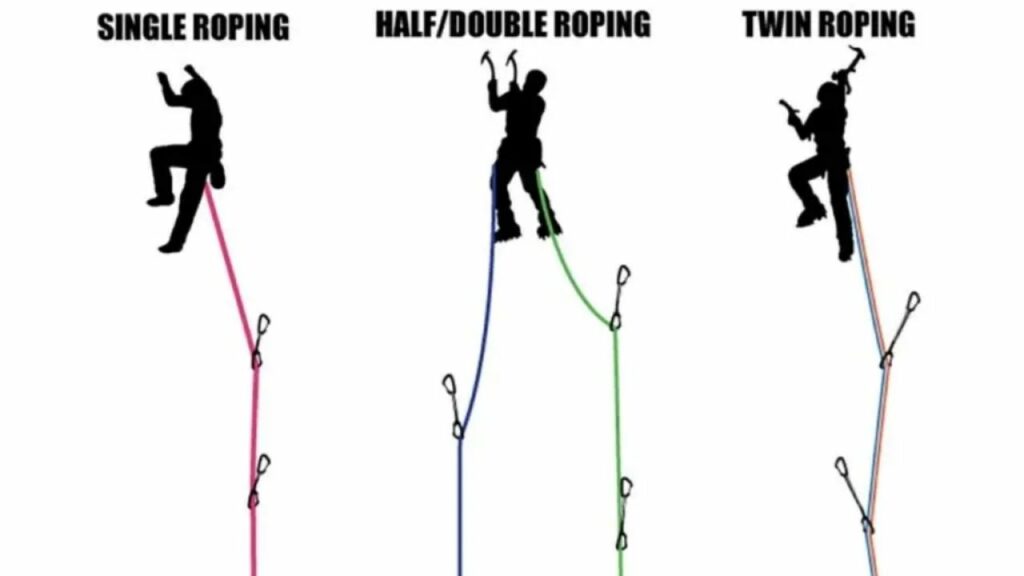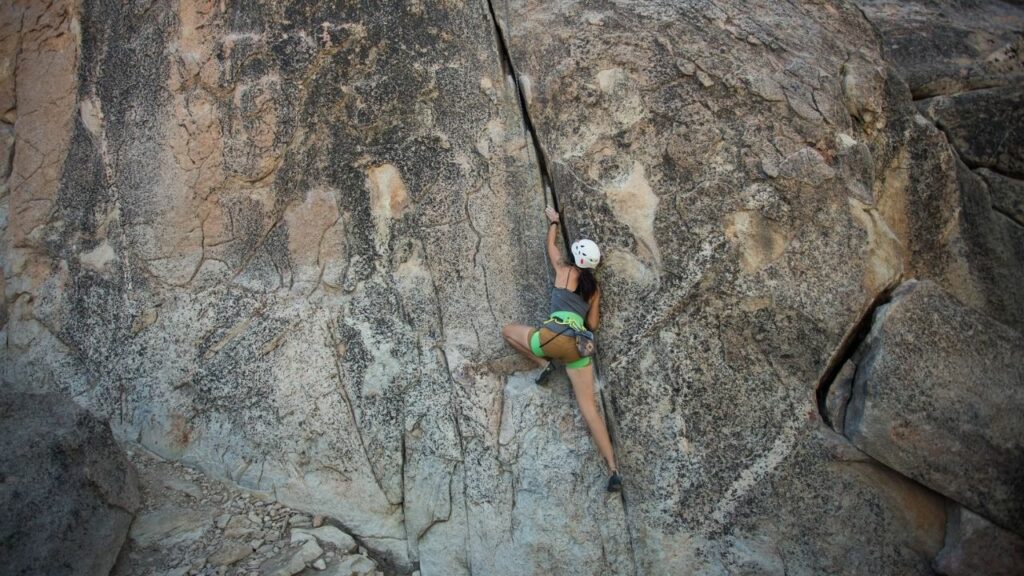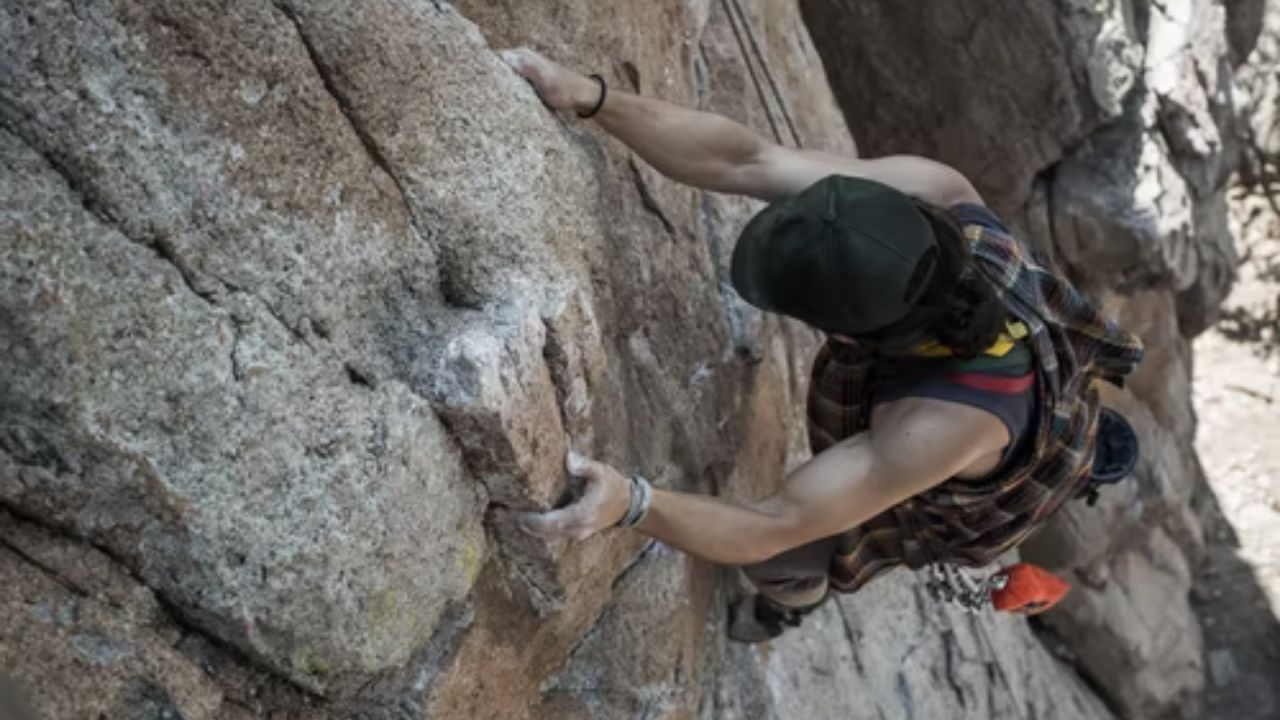Lead climbing, often called “sports climbing,” has gotten so popular that it just made its grand Olympic debut at the Tokyo Olympics 2021.
Yes, it’s just as cool as it sounds, but it’s also dangerous, so you need to be thoroughly prepared. You should be well aware of the necessary equipment and processes for the type of lead climbing you’ll be doing.
It includes choosing a rope with the ideal thickness that suits your physique and climbing, which is what we’ll discuss today.
You need at least 9.5mm (or preferably 10mm) for lead climbing. This is because it’s the right balance between durability (abrasion-resistance) and maneuverability (lightweight) that’s required in sports climbing.
What is lead climbing?
Lead Climbing is a type of sports climbing where climbers rock climb through a rope while clipping into fixed protections. They have quickdraws attached to their harnesses that can be further clipped to the bolts drilled into the rock (outdoor lead climbing) or the artificial wall (indoor lead climbing).
Now, the “ideal” thickness is a difficult question because there’s no one absolute answer. The ideal or advised thickness depends on multiple factors, including the type of rope you prefer and the type of lead climbing you’ll be doing.
Climbing Rope Diameter & Diameter
There are basically three types of climbing ropes: single, half-rope, and twin.

1. Single Rope
Single ropes just mean that they’re meant to be used alone and not with another rope. They’re super lightweight compared to half and twin ropes of the same dimensions.
2. Half Rope
“Half rope” is an ambiguous name because you’re technically using two ropes. While ascending, you basically clip one rope to the protection on the left and the other to the right.
This helps reduce drag when done right and works as a safety mechanism because you could count on at least one rope if the other fails or breaks. They’re not as lightweight as single ropes, but the effective weight is not as much since they’re used separately.
3. Twin Rope
You also use two ropes here, but both of them will be clipped through each piece of protection on both ends – similar to a single rope.
They’re the safest among the three ropes since the one-rope-backup mechanism is more close-knit than half ropes.
4. Which one do you need?
Single ropes are often considered the best for lead climbing and top roping, followed by half ropes. Most climbers in the United States usually go with single ropes when lead climbing on rocks and half ropes when mountaineering and ice climbing.
But you should consider twin ropes if you’re a beginner since they’re the safest of the three even though they require better control.
How thick should a lead climbing rope be?
Ideally, 9.5mm or 10mm thickness is perfect for single rope rock climbing. Still, using a diameter of 10mm or 10.5mm for lead climbing (or sports climbing) is recommended, especially when mountaineering and ice climbing. Thicker ropes, albeit heavier, are safer and more durable.
And if you’re going with half ropes or twin ropes, the ideal diameters would be 8-9mm and 7-8mm, respectively.
| Thicker Rope (10-10.5mm) | Thinner Rope (9.5-10mm) |
| They last longer, are safer and suitable for beginners. | They’re comparatively less durable. |
| They’re better for gym climbing. | They can be a bit slippery for beginners. |
| They weigh more and have more drag. | They give more performance and less drag due to the weight difference. |
In short, you can go with a thinner rope for sports or lead climbing, but even if you’re experienced in the sport, I wouldn’t go below 9.4mm in diameter.
Factors to Consider While Buying Climbing Rope
1. Climber’s Weight
As mentioned, the climber’s weight matters a tonne (pun intended) – UIAA uses 80kg (176 lbs) and 55kg (121 lbs) weight bags to test ropes, but the effective force is greater than the real-world scenario.
This graph plots measure weight vs. maximum drops certified as per UIAA standards for rope types and thickness.

Here, you can get more technical info and stats on fall vs. climber’s weight and fall durability versus abrasion durability. But we’ll break down the rest of the factors below.
2. Equipment Compatibility
Imagine buying a fantastic rope after a tonne of research, and it doesn’t fit in your belay device. That’d be a bummer, right? All climbing ropes are always used in sync with either a tandem device or a belay. First, filter your rope options based on equipment compatibility.
Every belay/tandem device has a specific range of rope diameter that it can fit. This information can be easily found on the manufacturer’s website.
3. Safety Guidelines
Safety matters most. The rope you buy should be on the better end of the durability scale and UIAA certified. An officially certified single rope can be less durable than a local or non-certified one. We’ll discuss UIAA certification in detail in the next section.
Frequently Asked Questions (FAQs)
1. How long do climbing ropes last?
Climbing rope can last at least 3-5 years on average, but the lifespan can be extended (or shortened depending on a number of factors). Some ropes last over 6-7 years if you don’t climb frequently and less than 1-2 years if you’re climbing 3-4 times a week.
2. What are the safety factors that determine rope quality?
The life span can also vary between two different sets of climbing rope models or companies. Be sure to check the safety ratings of your climbing rope set by Union Internationale des Associations d’Alpinisme (UIAA).
There are four major safety factors:
- Fall Rating: Fall ratings are determined by putting the ropes through a force greater than real-world falls to see how many they can endure before failing. Single and half ropes must endure 5 falls with 80kg and 55kg weights respectively to pass. And the twin ropes must endure 12 falls with 80kg weight on each strand.
- Static Elongation: It’s basically how much the rope elongates with an 80kg weight hanging from it. Single and half ropes must not elongate more than 10%, and the twin ropes should be less than 12% to pass the UIAA test. Static elongation is an essential factor in lead climbing and top-roping.
- Dynamic Elongation: It’s the percentage of elongation a rope goes through during its first fall. Dynamic elongation is confusing because a lower number would be preferable since more elongation equals more chances of the climber hitting the ground. Though if it’s low, you’ll feel an excessive amount of force due to inertia, and so will the belayer.
- Impact Force: It’s the amount of force (measured in kN) the falling weight experiences during the first fall. Impact Force determines the amount of force that’ll be experienced by the climber in a real-world scenario. The general relation is that more dynamic elongation will mean less impact force. Though both need to be properly balanced, as explained earlier.

3. How to maintain climbing ropes properly?
Climbing ropes often get worn down because of the wear and tear from climbing. This can be dangerous if you don’t take proper caution and care with your climbing rope.
As mentioned, all climbing ropes have a specific “life span,” but there’s always a difference between theory and practicality – sometimes the ropes succumb to wear and tear faster than the ideal number, especially when exposed to dirt and moisture.
A special treatment, called “dry treatment,” is necessary in those cases to extend the life span. It’s not that important when you’re lead climbing indoors (gym), but you should look into it if you lead climb outdoors.
The dry treatment generally costs about $40 to $50 and “protects” the rope against dirt and moisture, increasing its durability. You can either get dry treatment on just the sheath or both on sheath and core.
Dry treatment on the sheath is necessary if you’re climbing outdoors, and the rope frequently gets rubbed against sharp edges. Core dry treatment is usually done when you do ice (lead) climbing in alpine terrain.
The idea is to keep these general tips in mind and take proper care while you go for lead climbing of any kind. Of course, not worrying too much and enjoying the climb should be first on your list though. Happy climbing!

